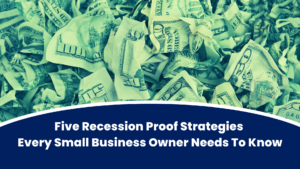Our guest blogger breaks down several key performance indicators (KPIs) that lenders look at before deciding on your business loan.
Special thanks to guest blogger Jessica Hornbeck, a professional accountant and outsourced CFO/COO, who, during a recent webinar, walked us through key KPIs businesses need to track to get funded.
Last time we reviewed the importance of the profit & loss statement and balance sheet and scratched the surface of those all-important metrics, you must track if you want to get funded. So roll up your sleeves because now we’re going to dig even deeper. Don’t worry. I promise not to give you too many numbers. And you can do all of this in Excel.
Killer KPIs
It may go without saying, but I’ll say it anyway: You should be using accounting software to run your P&L by month. You can use something like QuickBooks and dump the data into Excel. It doesn’t need to be pretty. You can leverage the power of Excel to do any of the KPI calculations I give you here.
One of your most important KPIs is gross profit margin, which is income minus the cost of goods sold divided by income. For example, if you sell $100,000 worth of bird feeders that cost $20,000 to produce, your gross profit margin is an excellent 80% ($100,000 – $20,000/$100,000).
But you don’t have to do the math. Instead, you can type that formula in Excel for each month and link it to the monthly trend that you ran on whatever accounting software you use. And it gives you the percentage.
Even though I’m in the numbers business, looking at numbers all day doesn’t inspire enthusiasm or necessarily tell me a story. So, a sparkline lets you see the 12-month trend. In Excel, you can create the sparkline for whatever length of time. I like to keep my eye on both the six-month and 12-month trendlines. It gives a visual which is cleaner and easier to view. If the gross margin is going down, I’ve got a problem. You want your gross margins to go up or at least stay steady.
You should also consider the industry benchmarks. For gross profit margin, I generally see from 60% on the low end to 70% on the high end. And, if you’re super lean, 80% would be excellent. But you want to stay above 60% because it means you have 60% income left over.
And next, we go to net profit margin – or the bottom line – one of the other most important KPIs. This is your net profit (after you pay out expenses) divided by your income. This is what remains at the end of the day.
So if you’re spending way too much on your cost of goods sold – your product or your labor – you’ll know. Maybe you have too many people sitting idle and have to let someone go if you’re not pulling in enough income. In a product business, you may be holding too much inventory and should not buy more until it’s sold.
So these metrics are meant to force you to change your behavior because you want to end up with a profitable business that makes money, right? A reasonable profit net margin is 30% or 20%. Once you start getting lower than that, it’s risky. It doesn’t feel good unless you have subscriptions or recurring revenue, which is another important metric because you can guarantee this income is coming in the door as long as you continue to meet this service.
KPIs don’t have to be financial.
One important note: KPIs don’t always need to be financial. For example, a construction business might have non-financial metrics like the number of trouble calls, safety training completion, number of crew onboarding, etc. I recommend you keep a weekly scorecard.
Yes, you can track some financial things, such as sales or the number of customers converted. But when you’re getting paid can be equally important—for instance, monitoring invoices outstanding over 60 days. If that payment time keeps growing, consider a retainer policy where you collect money upfront for services instead of invoicing. You may need to switch up who’s managing accounts receivable and get the tough guy on the phone to extract those payments.
But the goal is to look at your numbers and look at those other operational areas you need to stay on top of so you can make adjustments as you need to. Marketing can be a metric you keep an eye on or the number of visitors to our website or social media. It doesn’t always have to be financial metrics. Get in the habit of having a weekly conversation with yourself and your team members to force accountability.
Get proactive in real-time so you can change behaviors and increase your margins, get more money in the door, and get more profitable. And keep getting lean with operational metrics. In our company, we look at utilization rates. We talk about how many leads we reached, how many we closed, and what we’re upselling. Your existing customers are the best way to increase sales. They’re already your customers. What other services can you offer them?
We also have a client satisfaction metric in my company. We reach out to every client to make sure everyone is happy.
On seeking funding.
People sometimes discount bootstrapping because it keeps you from growing as fast. But the one thing it does do is keep you in control. And the best time to borrow money is when you don’t need it. You want to be dealing from a position of strength. If you’re asking friends or family for money, tell them how great of an opportunity you have with your company. You’re not looking for a handout; you’re looking for an investment. Make them feel good about coming on board.
Likewise, lenders can tell when you’re desperate for money to stay solvent vs. when you want money to help your company grow to another level. They look at the same KPIs that I just told mentioned. The more comfortable you understand the critical KPIs for your business, the more you can use them to improve your business, and the more likely you will get a loan with good terms.
It’s also not just about the dollars, though. With any lender or investor, it’s going to also be about the relationship. Will they help you grow? Will you learn from them? Are they people you want to work with? What else can they do to help you further develop your business?
Your business success depends on a multitude of factors. Metrics are a crucial component of that. So is finding the right lender when you want to grow. Luckily they go hand in hand. When you have good metrics, you can attract the right lender.
Interested in funding? Take a look at different financing options from our partners.




